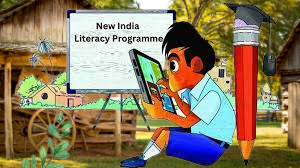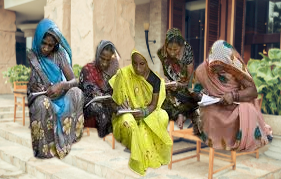New India Literacy Programme: Bridging the Gap between Education and Development

Introduction-
Government approved a new scheme “New India Literacy Programme (नव भारत साक्षरता कार्यक्रम) for the period FYs 2022-2027 to cover all the aspects of Adult Education to align with National Education Policy 2020 and Budget Announcements 2021-22. The National Education Policy 2020 has recommendations for Adult Education and Lifelong Learning.
The New India Literacy Programme (NILP) is a flagship initiative by the Government of India, aimed at improving the literacy rate and quality of education in the country. With a population of over 1.3 billion, India has one of the largest education systems in the world, but also one of the highest illiteracy rates. The NILP is a step towards bridging this gap and creating a literate and educated society.
The Need for NILP
The NILP was launched in response to the need for a more effective and coordinated effort towards improving literacy and education in India. Despite the efforts of the government and various organizations, the illiteracy rate in India is still high, especially among women and rural communities. The NILP aims to address this issue by providing quality education and promoting a culture of learning.
The Importance of Education
Education is a crucial component of personal and societal development. It equips individuals with the necessary skills and knowledge to make informed decisions, participate in the workforce, and contribute to the growth of their communities. Education also plays a vital role in reducing poverty and promoting social equality.
Challenges Faced in Education
India faces numerous challenges in the education sector, such as the lack of access to education in rural areas, inadequate infrastructure, and insufficient funding. Additionally, there are disparities in the quality of education provided, with urban areas generally having better facilities and resources than rural areas.
Salient Features of the scheme

- School will be Unit for implementation of the scheme.
- Schools to be used for conducting survey of beneficiaries and Voluntary Teachers (VTs).
- Different strategies are to be adopted for different age cohorts. Flexibility for States/UTs will be provided to undertake innovative activities.
- Foundational Literacy and Numeracy will be imparted through Critical Life Skills to all non-literates in the age group of 15 years and above.
- Use of Technologies to impart Adult Education for wider coverage of the scheme.
- Performance Grading Index (PGI) for State/UT and district level will show the performance of States and UTs to implement the scheme and achievements on yearly basis by weighing both the physical and financial progress through UDISE portal.
- CSR/Philanthropic Support may be received by hosting ICT support, providing volunteer support, opening facilitation centers for learners and for providing IT access to economically weak learners in the form of cell phones, etc
- Priority and Saturation in Literacy- The age cohort of 15-35 will be saturated first, followed by ages 35 and above. Priority will be given in terms of categories to the girls and women, SC/ST/OBC/Minorities, Persons with Special Needs (Divyangjans), Marginalized/ Nomadic/ construction workers/ laborers/etc. who can substantially and immediately benefit from adult education.
In terms of location/area, the focus shall be on all aspirational districts of NITI Aayog, districts with literacy rates less than the National/State average, districts with female literacy rates less than 60% as per the 2011 Census, Districts/ Blocks with large SC/ST/ Minority population, Educationally Backward Blocks, Left Wing Extremism Affected districts.
- Convergence with Ministries and Departments for effective implementation of NILP: MeitY: Digital Literacy, DFS/MoF: Financial Literacy, MoSDE: Skilling, DoJ/MoLJ: Legal Literacy, MoD: Involvement of NCC Volunteer and Ex- Servicemen, MoYAS: Involvement of NYKS, NSS, MoRD: NRLM and DDU-GKY, MoC: Involvement of Cooperative Societies, MoHFW: Health and Hygiene Literacy, NDMA/MHA: Disaster Management, MoMA: for implementing among Minorities, DoHE: Continuing Edn, Min of Culture: Libraries, Cultural Literacy, MoPR: For Panchayat support, Rural Libraries, MWCD: Involvement of Anganwadi Workers, and MoTA: Implementing in Tribal areas etc. READ ALSO- PIB
Objectives of NILP

The NILP has set several objectives to achieve its goal of creating a literate and educated society. Some of these objectives include:
Improving Literacy
The NILP aims to improve literacy rates by providing quality education to individuals who are unable to attend formal schools. This includes adult learners, women, and marginalized communities.
Ensuring Quality Education
The NILP seeks to ensure that the education provided is of high quality and meets national standards. This includes training teachers and providing them with the necessary resources to deliver quality education.
Promoting a Culture of Learning
The NILP aims to promote a culture of learning by creating awareness about the benefits of education and encouraging individuals to take an active interest in their personal and societal development.
Implementation of NILP
The NILP is being implemented through a variety of programs and initiatives, including:
Adult Education Program
The Adult Education Program provides basic education and literacy skills to adults who were unable to complete their education. The program also offers vocational training to help individuals acquire employable skills.
Saakshar Bharat Mission
The Saakshar Bharat Mission is a national program that aims to improve the literacy rate among women. The program focuses on creating a gender-sensitive and inclusive learning environment for women.
Rashtriya Madhyamik Shiksha Abhiyan
The Rashtriya Madhyamik Shiksha Abhiyan is a program that aims to increase the enrollment of students in secondary education. The program provides financial assistance to states to improve infrastructure, upgrade schools, and train teachers.
Impact of NILP

The NILP has had a significant impact on the education sector in India. Some of the key impacts include:
Increase in Literacy Rates
Since the launch of NILP, the literacy rate in India has increased from 73% to 77%. The program has been successful in providing basic literacy skills to adults and improving the overall literacy rate in the country. READ ALSO- Vibrant Village Programme
Improved Quality of Education
The NILP has contributed to improving the quality of education provided in India. The program has trained teachers, upgraded infrastructure, and provided resources to schools, resulting in a better learning environment for students.
Empowering Women
The NILP has been instrumental in empowering women by providing them with access to education and vocational training. This has led to an increase in women’s participation in the workforce, improving their socio-economic status and reducing gender inequality.
Bridging the Rural-Urban Divide
The NILP has helped bridge the gap between rural and urban areas by providing education and training to individuals in remote and underdeveloped areas. This has led to an increase in opportunities for individuals from marginalized communities, helping to reduce poverty and promote social inclusion.
NILP as Janandolan

The three crores students/children of around 7 lakh schools registered under UDISE along with about 50 lakh teachers of Government, Aided and Private schools will participate as volunteer.
An estimated 20 lakh students from Teacher Education and Higher Education Institutions will be actively involved as volunteers.
Support will be garnered from PRIs, Anganwadi workers, ASHA workers and an estimated 50 lakhs NYSK, NSS and NCC volunteers.
There will be involvement of community, participation of philanthropic/CSR organizations through volunteerism and through Vidyanjali portal.
States/UTs will promote individual/ family/ village/ district success stories through various platforms.
It will utilize all types of media – Electronic, Print, Folk & Inter-personal platforms including social media platforms like Facebook, Twitter, Instagram, WhatsApp, YouTube, TV channels, radio, etc.
Challenges and Future Directions

Despite the success of the NILP, there are still challenges that need to be addressed. Some of these challenges include:
Ensuring Sustainability
The NILP must ensure that its programs and initiatives are sustainable and continue to have a long-term impact. This includes investing in infrastructure and resources and ensuring that trained teachers remain in the education sector.
Addressing the Digital Divide
The COVID-19 pandemic has highlighted the digital divide in India, with many individuals unable to access online education. The NILP must address this issue by providing digital infrastructure and resources to individuals who are unable to attend physical schools.
Promoting Inclusivity
The NILP must ensure that its programs are inclusive and cater to the needs of marginalized communities. This includes addressing issues of caste, gender, and disability and providing equal opportunities for all individuals to access education.
Conclusion
Adult Education (प्रौढ़ शिक्षा) is now ‘Education for All’ in the country: As a progressive step, it has also been decided that from now onwards that the term “Education For All” will be used in place of “Adult Education” by the Ministry in view of the fact that the terminology “Adult Education” is not incorporating appropriately all non-literates of 15 years and above age group.
As per Census 2011, the absolute number of non-literates of the country in 15 years and above age group is 25.76 crore (Male 9.08 crore, Female 16.68 crore). In consideration of the progress of persons certified as literates being to the tune of 7.64 crore under the Saakshar Bharat programme implemented during 2009-10 to 2017-18, it is estimated that currently around 18.12 crore adults are still non-literate in India.
The New India Literacy Programme is a significant step towards creating a literate and educated society in India. Through its programs and initiatives, the NILP has helped bridge the gap between education and development, empowering individuals and reducing poverty and inequality. However, there are still challenges that need to be addressed, and the NILP must continue to innovate and adapt to ensure that it achieves its objectives.
FAQs
What is the New India Literacy Programme?
The New India Literacy Programme is a flagship initiative by the Government of India aimed at improving the literacy rate and quality of education in the country.
How has the NILP impacted the education sector in India?
The NILP has contributed to improving the quality of education provided in India, increasing literacy rates, and empowering women.
What are the challenges faced by the NILP?
The NILP faces challenges such as ensuring sustainability, addressing the digital divide, and promoting inclusivity.
How is the NILP addressing the issue of the digital divide?
The NILP is addressing the issue of the digital divide by providing digital infrastructure and resources to individuals who are unable to attend physical schools.
What is the future direction of the NILP?
The NILP must continue to innovate and adapt to address the challenges it faces and ensure that its programs are sustainable, inclusive, and have a long-term impact.
Sourse- PIB
1 thought on “New India Literacy Programme”